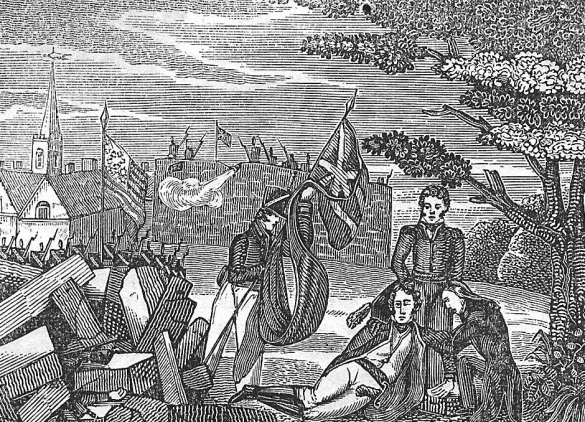
Zebulon Montgomery Pike (1779-1813) was a soldier best known for his exploration of the Louisiana Territory and leadership in the Battle of York.
This piece was created by an unknown artist in 1844 and depicts the death of American Brigadier-General Zebulon Pike at the Battle of York near York, present day Toronto.
It was the first American win in the War of 1812, a pivotal war against Great Britain. The British were already in the middle of a global war against France which was one of the causes of the War of 1812. Since the French-British war had broken out in 1793, both countries made efforts to restrict international trade. This put the United States in a difficult position because they were unable to trade with either world power without facing the wrath of the other.((Eland, Ivan. “Most Wars in American History Were Unnecessary and Undermined the
Republic.” Mediterranean Quarterly, vol. 23 no. 3, 2012, p. 4-33.)) After trying to enact many fruitless embargos and acts against the European powers, the United States fell into an economic depression. In addition, the British continued to forcibly recruit American sailors into the Royal Navy through “impressment” and dismissed America’s claim to neutrality in the global war, effectively dismissing the former colony’s national legitimacy.((A Brief Overview of the War of 1812. American Battlefield Trust. (2021, March 25).
https://www.battlefields.org/learn/articles/brief-overview-war-1812.)) All of these factors combined is what led President James Madison to instruct Congress to prepare for war with Britain.
The Battle of York took place in April of 1813 and was an easy win for the Americans that went wrong. This battle was meant to be part of a much larger American plan to capture the Town of Kingston, destroy its naval dockyards, capture or destroy the Provincial Marine Naval Squadron, and cut off the line of supply to the British Army in the western forts in Upper Canada. After pushing the British troops out of York, General Pike and his troops entered the forts and began questioning British prisoners for military intel. However, while this was happening, York’s Grand Magazine exploded, wounding 222 and killing 38, including General Pike.((Hurley, Michael. “The Battle & Burning of York: America’s First Victory in the War of 1812.”
UELAC, vol. 8, no. 11, Dec. 2011)) Since the soldiers were without their trusted General, during the five days when the details of the surrender were being worked out, the Taking of York became the Burning of York. The soldiers were given strict orders to not touch private property, yet many public buildings and private homes were looted and burned.
This battle-turned-tragedy took place on Canadian land, but it became pivotal to American history because it led directly to the Burning of Washington a year later. The Burning of Washington was incredibly important to the American people because it demonstrated how ill prepared the new country was when compared to the more established world powers. The capital was devastated which was a large setback for the country and caused many people to lose confidence in the new republic.((Garrard, Graeme. “Washington Is Burning.” History Today, vol. 64, no. 8, Aug. 2014, pp. 37–43.)) While the Burning of Washington was not the United States’ proudest moment, the Burning of York is a story of a strong hero leading Americans to victory. The message being conveyed here is one of great American success. Americans wanted to remember the successful battle and the hero that was General Zebulon Pike because he is an example of a true American hero. The choice to depict the story in which the United States was the successful underdog, reflects the nationalism that existed. Considering this, it makes sense that even decades later, in 1844, this battle and the death of this General was still so prevalent to the American society that it continued to be a subject of discussion and art.

The British Royal Standard of 1801-1816.

The official flag of the United States from 1795-1818.
The drawing is a great depiction of this event because the choices made by the artists help the viewers understand the entire situation. One detail that expresses the United States’ success is the removal of the British Canadian flag and the American one in the distance. In the foreground of the image, is an American soldier taking down the flag that once stood on the forts in York, and in the background, the United States flag is erected proudly. While this was a literal occurrence during the battle, the emphasis put on the removal of the British Canadian flag and the inclusion of the United States flag in the background of the picture, symbolizes the outcome of the battle and the transfer of power that later proved to be brief. Another detail of the foreground is the rubble next to the injured man. The destroyed building and the man on the floor, who is known to be General Pike, gives the viewer an insight into the events that followed the United States’ successful taking of York. In the background a military fort can be seen intact next to, what appears to be, a civilian building. The presentation of these buildings still intact and the specification that General Pike is just injured rather than dead, allows the viewer to determine what day this artist was trying to depict. The artist drew the time directly after what is known as the Taking of York, but prior to the violence and destruction that became known as the Burning of York. The details included in this work of art gives the viewer great insight into what is known about these events.
